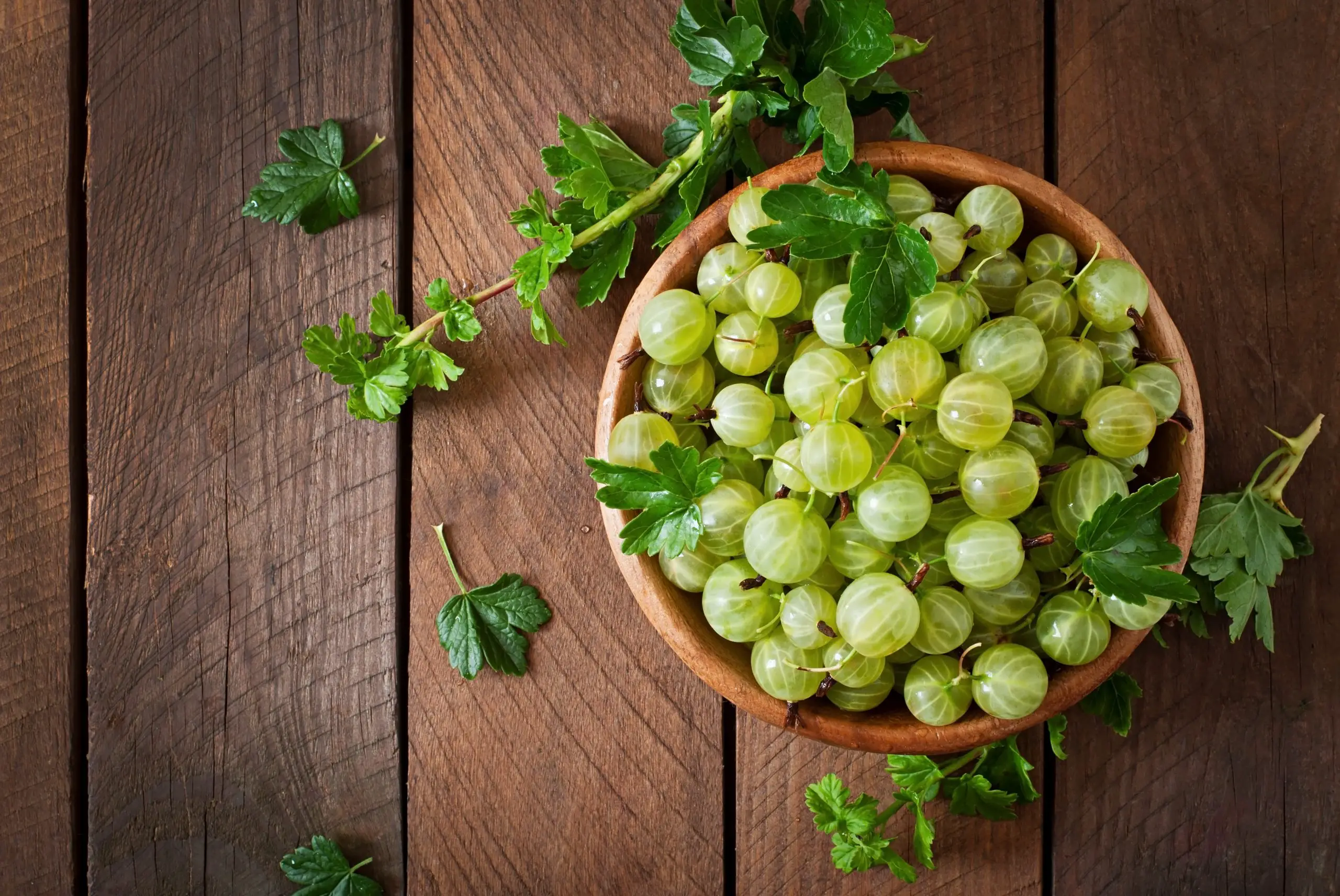Amla Juice: Top 10 Health Benefits of Amla Juice, Nutritional Facts

Amla Juice is not just a pretty green drink, it has a variety of awesome benefits! Read on to find out more!
Does eating an amla jog your memory of when you hid them from your mum and lied to her that you ate it?
Oh if only you knew the benefits it had to offer, maybe you would’ve eaten it after all!
Do you think Amla Juice can help maintain your hair, nails, teeth, and skin?
It sure can, and these are just the tip of the iceberg when it comes to its benefits!
For those of you who haven’t come across this fruit,
What is Amla?
Amla is also known as the Indian gooseberry.
It is the fruit of a deciduous tree of the Phyllanthaceae family that grows natively in parts of Asia, India being one of the most popular ones.
The amla fruit is yellow-green and has a very prominent taste. The taste it offers is unlike that of any other fruit. It has a sour, astringent taste that leaves a lingering sweet aftertaste. You can often taste the sweetness once you drink water right after eating this fruit.
Incredible isn’t it?!
The texture is like that of a crunch granny smith apple. The skin is a little tough, and the flesh is crunchy, fibrous, and incredibly juicy.
| Did you know that the seed of the amla fruit, although not edible as is, can be ground and powdered and used for various medicinal purposes?! |
One of the most common methods of eating this fruit is by juicing it. Amla juice offers a series of health benefits. Drinking it can do wonders for your body and your health.
What are the benefits of drinking Amla juice?
The health benefits of amla juice are not limited to your hair, nails, and skin.
There is more than amla juice can offer, and mentioned below are a few,
1. Promotes immune function and limits oxidative damage
Amla is rich in vitamin C and various other antioxidants. [1]
Vitamin C has been known to contribute to immune defense by supporting various cellular functions of both the innate and adaptive immune systems [2].
The antioxidants present might also help protect the cells against oxidative damage that can be caused by arsenic, a pollutant widely distributed in the environment and known to cause severe health issues like skin lesions, cancer, cardiovascular and immunological disorders [3].
2. Enhances liver health
Amla can prevent liver toxicity from iron overload, and the toxic effects of various hepatotoxic agents like ethanol, heavy metals, paracetamol, carbon tetrachloride, and antitubercular drugs.
It can also mitigate hyperlipidemia, a condition wherein there is an excess of lipids in your blood, and various other conditions also known as metabolic syndrome.
Amla also has beneficial effects on the functioning of the liver [4].
3. Maintains healthy intestines
The dietary fiber present in amla helps regulate bowel action and is known to aid digestion.
The fermentation of these fibers positively impacts the composition of bacterial communities in the intestines that contribute to the health of your gut [5, 6].
4. Promotes heart health
Amla is considered to be an effective medication when it comes to cardiovascular health.
It is known to have antiplatelet, vasodilatory, anticoagulant, antihypertensive, anti-inflammatory, antioxidant, and lipid deposition inhibitory effects on the human body.
Although further studies are required regarding the prevention of cardiovascular diseases, amla can reduce the risk factors of having a cardiovascular disease to a certain extent [7].
5. Improves kidney health
Often, oxidative stress can also be a cause of renal dysfunction.
Due to its antioxidants, amla can help prevent this by reducing the elevated levels of serum creatinine and urea nitrogen.
The positive result of amla extract in preventing renal diseases caused due to aging in rats indicates that amla might be a valuable antioxidant for the prevention of age-related renal dysfunction [8].
6. Manage diabetes and control blood sugar levels
The anti-hyperglycemic and lipid-lowering properties of amla have shown signs of keeping in check one’s diabetes and blood sugar levels.
Certain compounds present in amla, like gallic acid, gallotannin, ellagic acid, and corilagin, are also known to possess anti-diabetic properties. Amla is also known to prevent or reduce hyperglycemia, neuropathy, cardiac complications, diabetic nephropathy, protein wasting, and cataractogenesis, also known as the process of cataract formation.
Although there is limited information regarding clinical trial data with humans, it has paved the way for further research [9, 10].
7. Improve eye health
The vitamin A present in amla is known to benefit your eye health and improve vision. The constituents of vitamin A, like beta-carotene, is known to reduce the risk of macular degeneration and cataract, which is often the result of aging [11, 12].
8. May prevent Cancer
Amla is known to possess radio modulatory, chemo modulatory, chemopreventive effects, which summarizes to say that it can help prevent side effects that might come with radiotherapy, chemotherapy and other radiation-related procedures.
It is also an antioxidant that possesses anti-inflammatory, antimutagenic, and immunomodulatory properties that are known to prevent cancer.
However, further research is required to establish the efficacy of amla as a cancer preventative fruit [13].
What are the beauty benefits of amla?
1. May increase hair growth
Amla oil is known to increase hair growth when applied directly to the scalp.
Amla powder can also be used as a topical paste or hair mask and applied.
It acts as a hair tonic and strengthens and promotes hair growth.
It stimulates the hair follicles, and the vitamin C present improves collagen production.
Amla also keeps your scalp hydrated [14].
2. Anti-aging
Amla can help increase the production of collagen and acts as an anti-aging substance. This can help the skin retain its youthfulness and prevent the development of fine lines [15, 16].
How to make Amla Juice at home?
Preparing Amla Juice is anything but complicated and does not take up a significant part of your day.
All you have to do is add around 2-5 gooseberries in a blender along with 1-2 cups of water and blend until you are left with a coarse liquid. Strain and filter this liquid and remove any pulp that might’ve been left behind, and there you go!
Your Amla Juice is ready to be served!
Note – The proportions for this recipe vary depending on how much you intend to make at a time.
When to drink Amla Juice?
Amla Juice is best absorbed by the body when consumed on an empty stomach. Therefore, drinking it first thing in the morning would be considered ideal.
However, try and avoid drinking it at night since you might catch a cold and might also sleep with a bitter taste in your mouth, and that definitely isn’t a pleasant feeling to fall asleep with!
How to consume Amla Juice?
This juice can be consumed with other ingredients like ginger, black pepper, honey, or sea salt.
You can also try mixing it with aloe vera juice, adding it to bottle gourd juice along with honey, or you could just add some to your water and consume as-is.
Amla Nutrition Value per 100 grams
Nutrition facts of 100g of amla according to the USDA [17].
| Nutrient | Content in 100 g |
| Carbohydrate | 10.2 g |
| Fiber | 4.3 g |
| Protein | 0.88 g |
| Total fats | 0.58 g |
| Potassium | 198 mg |
| Vitamin C | 27.7 mg |
| Phosphorus | 27 mg |
| Calcium | 25 mg |
| Magnesium | 10 mg |
| Sodium | 1 mg |
| Vitamin B5 | 0.286 mg |
| Manganese | 0.144 mg |
| Vitamin E | 0.37 mg |
| Iron | 0.31 mg |
| Zinc | 0.12 mg |
| Selenium | 0.6 mcg |
| Vitamin B3 | 0.3 mg |
| Vitamin B6 | 0.08 mg |
| Copper | 0.07 mg |
| Vitamin B1 | 0.04 mg |
| Vitamin B2 | 0.03 mg |
| Vitamin A | 87 mcg |
| Vitamin B9 | 6 mcg |
Precautions you might want to take while consuming Amla
- Due to amla’s anti-platelet property, you shouldn’t consume it before or after surgery since it could increase the risk of bleeding [18].
- Amla should be consumed with caution if you have diabetes since it could drastically drop your blood sugar levels [9].
- Excess amla might cause dryness of the skin.
Due to limited research regarding the side effects of amla, always consult a doctor before consuming any, especially if you happen to be sick, pregnant or if you are experiencing various other conditions.
Is amla the only fruit that is highly nutritious?
No!
Kiwi is also one of the most nutrient-dense fruits. Take a look at the benefits of kiwi and let us know in the comments which fruit you prefer!
FAQs
Q: Can you drink amla juice every day?
A: Yes, you can drink amla juice every day.
You can either eat one fruit a day or consume around 10-20ml of amla juice as is, or diluted with water or with other ingredients.
Q: Can Amla juice help you lose weight?
A: Yes!
The fiber present in amla can help keep you full for more extended periods and can help manage your hunger. The antioxidants also help in increasing your metabolism.
These factors positively contribute to your weight loss journey.
Q: When is the right time to consume amla juice?
A: The benefits of drinking amla juice on an empty stomach is higher than when consumed right after a meal.
Therefore consuming it at any time of the day but on an empty stomach would be ideal.
Q: Should I drink amla juice in the morning or at night?
A: Drinking amla juice at night is not recommended since the chances of you falling ill increases. However, as long as you are drinking amla juice daily, it doesn’t matter at what time of the day you consume it.
Wrapping Up
Amla is a diverse fruit regarding its consumption, is highly nutritious, and can contribute to your nutritional wellness.
It can be eaten as is, candied, pickled, or juiced, and will still retain all of its nutritional benefits.
However, there are certain precautionary measures you must take while consuming this fruit.
If you happen to experience certain health issues, consult your doctor before incorporating amla juice into your diet.
References
- Jain, Shashi Kumar, and D S Khurdiya. “Vitamin C enrichment of fruit juice based ready-to-serve beverages through blending of Indian gooseberry (Emblica officinalis Gaertn.) juice.” Plant foods for human nutrition (Dordrecht, Netherlands) vol. 59,2 (2004)
- Carr, Anitra C, and Silvia Maggini. “Vitamin C and Immune Function.” Nutrients vol. 9,11 1211. (2017)
- Singh, Manish K et al. “Immunomodulatory role of Emblica officinalis in arsenic induced oxidative damage and apoptosis in thymocytes of mice.” BMC complementary and alternative medicine vol. 13 193. (2013)
- Thilakchand, Karadka Ramdas et al. “Hepatoprotective properties of the Indian gooseberry (Emblica officinalis Gaertn): a review.” Food & function vol. 4,10 (2013): 1431-41.
- NIH. “Dietary Fiber.” Medline Plus.
- Holscher, Hannah D. “Dietary fiber and prebiotics and the gastrointestinal microbiota.” Gut microbes vol. 8,2 (2017): 172-184.
- Hashem-Dabaghian, Fataneh et al. “A systematic review on the cardiovascular pharmacology of Emblica officinalis Gaertn.” Journal of cardiovascular and thoracic research vol. 10,3 (2018): 118-128.
- Yokozawa, Takako et al. “Amla (Emblica officinalis Gaertn.) attenuates age-related renal dysfunction by oxidative stress.” Journal of agricultural and food chemistry vol. 55,19 (2007): 7744-52.
- Akhtar, Muhammad Shoaib et al. “Effect of Amla fruit (Emblica officinalis Gaertn.) on blood glucose and lipid profile of normal subjects and type 2 diabetic patients.” International journal of food sciences and nutrition vol. 62,6 (2011): 609-16.
- D’souza, Jason Jerome et al. “Anti-diabetic effects of the Indian indigenous fruit Emblica officinalis Gaertn: active constituents and modes of action.” Food & function vol. 5,4 (2014): 635-44.
- NIH. “Vitamin A.” Health Professional fact sheet.
- Kavitha Nair, Nair et al. “Effect of Aqueous Extract of Embelica officinalis on Selenite Induced Cataract in Rats.” Iranian journal of pharmaceutical research : IJPR vol. 9,2 (2010): 147-52.
- Baliga, Manjeshwar Shrinath, and Jason Jerome Dsouza. “Amla (Emblica officinalis Gaertn), a wonderberry in the treatment and prevention of cancer.” European journal of cancer prevention : the official journal of the European Cancer Prevention Organisation (ECP) vol. 20,3 (2011): 225-39.
- Yu, Jae Young et al. “Preclinical and Clinical Studies Demonstrate That the Proprietary Herbal Extract DA-5512 Effectively Stimulates Hair Growth and Promotes Hair Health.” Evidence-based complementary and alternative medicine : eCAM vol. 2017 (2017): 4395638.
- Fujii, Takashi et al. “Amla (Emblica officinalis Gaertn.) extract promotes procollagen production and inhibits matrix metalloproteinase-1 in human skin fibroblasts.” Journal of ethnopharmacology vol. 119,1 (2008): 53-7.
- Uchiyama, Taro et al. “Oral intake of lingonberry and amla fruit extract improves skin conditions in healthy female subjects: A randomized, double-blind, placebo-controlled clinical trial.” Biotechnology and applied biochemistry vol. 66,5 (2019): 870-879.
- USDA. “Gooseberries, raw.” Food Data Central.
- Hashem-Dabaghian, Fataneh et al. “A systematic review on the cardiovascular pharmacology of Emblica officinalis Gaertn.” Journal of cardiovascular and thoracic research vol. 10,3 (2018)
![Blue Foods List [with pictures]](https://keevs.com/wp-content/uploads/2023/03/Blue-Foods-List-with-pictures-300x158.png)






